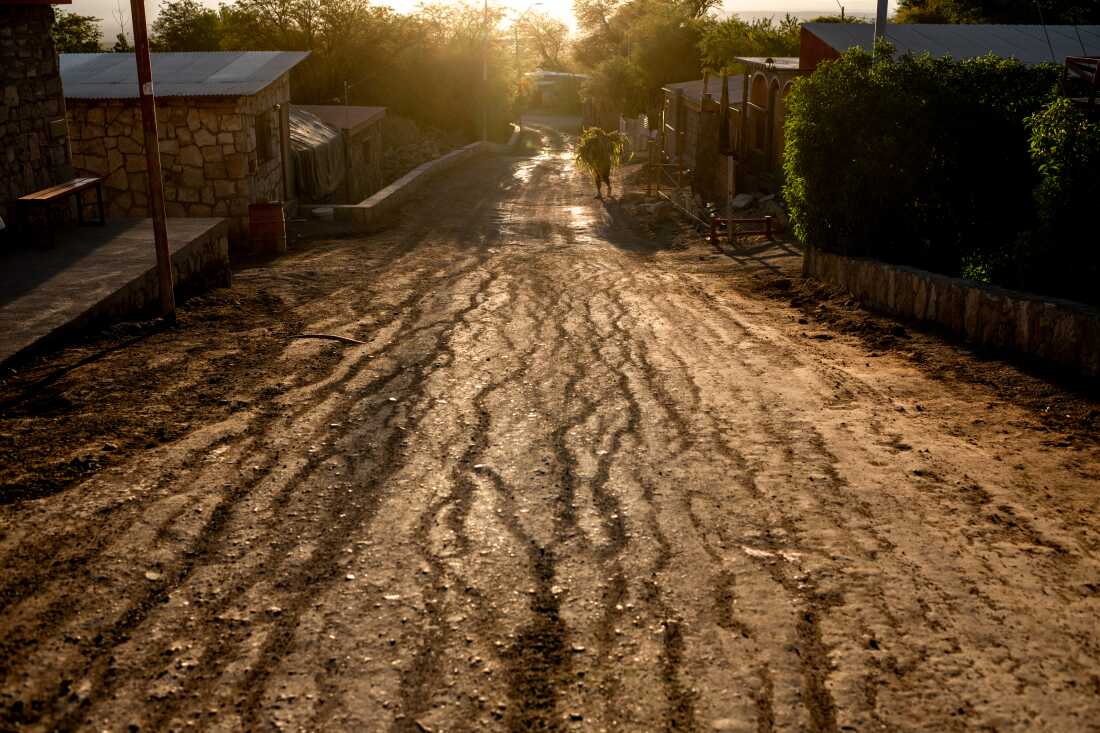
The town of Peine, near the Salt flats and one of the closest towns to the lithium mining operations. 13th of April, 2024. Antofagasta, Chile.
Cristóbal Olivares for NPR
hide caption
toggle caption
Cristóbal Olivares for NPR
ATACAMA DESERT, Chile — At the top of a craggy path in Socaire, a hilltop village deep in Chile’s Atacama Desert, a black flag whips in the wind above Jeanette Cruz’s house.
The desert sun has bleached it to a dark gray blur, but the defiance it represents remains strong.
Above each house in the village, shimmering in the evening sun, these black flags represent the Indigenous Lickanantay people’s resistance to the lithium mining that many say is tearing their communities apart.
The lithium in the brine beneath the brilliant white Atacama salt flat, which stretches out across the valley floor, has become a global resource.

The town of Peine, near the Salt flats and one of the closest towns to the lithium mining operations.
Cristóbal Olivares for NPR
hide caption
toggle caption
Cristóbal Olivares for NPR
It holds the key to the global green energy transition, but the Lickanantay communities that have inhabited the area for millennia are wondering what they themselves stand to gain.
“Our life is contained in that water,” says Cruz, gesturing forlornly out toward the salt as she stands in the low doorway to her home. “The day it dries up, we’re dead as a culture, and we will have to leave.”
“They can give us all the money and resources they want, but we’ll never get back what we’re losing.”
Before it can be refined, lithium-rich brine is pumped to the surface and mixed with groundwater, then slowly transferred between turquoise pools on the surface of the salt flat where it evaporates.
The concentrated lithium carbonate salts are driven in great convoys of trucks to the city of Antofagasta on the coast, where they are purified and exported to be made into batteries — and end up in your cellphone or electric vehicle.
Three companies have now set up operations on the Atacama salt flat.

Tilopozo, a former wetland, that according to Peine inhabitants, dried because of the water extraction by Lithium companies. Saturday 13th of April, 2024. Antofagasta, Chile.
Cristóbal Olivares for NPR
hide caption
toggle caption
Cristóbal Olivares for NPR
SQM, a Chilean chemical company, has been operating there since the 1980s. U.S.-based Albemarle Corp. has had a concession since 2015, and Chinese electromobility giant BYD are the latest to set up operations.
All three have rental contracts with Chile’s state development body, CORFO, through which money is set aside for the “sustainable development of the communities.”
“What I have seen in the area is that we are able to work, at least in some way, with each of the communities, which wasn’t the case before,” explained Javier Silva, who has been managing SQM’s relations with the communities around the Atacama salt flat for three years.
“We are seeing that perceptions are improving, although you always find a wide range of opinions.”
As part of their contract with CORFO, SQM shares out $15 million per year equally between 19 communities in the area; while further payments are made according to factors such as population and distance from the mining operations.
SQM has agreements with five communities, through which it works on health care, education, cultural and infrastructure projects.
Residents in the town of Peine at the far end of the salt flat, meanwhile, say that they have had an agreement in place with Albemarle since 2012. Some of the money was used to lay a brand new soccer field at the foot of the town.

A football court, paid by lithium companies, in the indiginous community of Peine, the closest town to the lithium mining operations, in the Atacama Salt Flat on Saturday 12 of April, 2024. Antofagasta, Chile.
Cristóbal Olivares for NPR
hide caption
toggle caption
Cristóbal Olivares for NPR
ByD declined a request for comment.
Chile is the world’s second-largest producer of lithium and has the largest known reserves of the mineral, according to the U.S. Geological Survey.
But there is little consensus among locals as to what should be done with the proceeds of the lithium boom.
Some of the communities around the salt flat have accepted direct compensation from the companies. Others are adamant that the damage being done is irreparable and cannot be offset by payments.
“The lithium won’t last forever,” sighs 72-year-old Sara Plaza, a lifelong resident of Peine. “For the next generations there won’t be water and there won’t be work — there won’t be anything.”
“It’s the richness of the culture and community spirit that’s disappearing. It’s not like it was before, and it’ll never be like it used to be. I don’t see such a bright future anymore.”
Down on the plains, razor-sharp crusts of salty rock jut skyward like frozen waves, and tufts of tough grass protrude between them.
Plaza walks with total ease over the rough ground, pointing out places on or just over the featureless horizon which aren’t obvious to foreign eyes.

Sara Plaza member of the indiginous community of Peine, walks near a water extraction well in Tilopozo, a former wetland.
Cristóbal Olivares for NPR
hide caption
toggle caption
Cristóbal Olivares for NPR

Sara Plaza (72) member of the indiginous community of Peine, stands in Tilopozo, a former wetland, that according to Peine inhabitants, dried because of the water extraction by Lithium companies. Saturday 13th of April, 2024. Antofagasta, Chile.
Cristóbal Olivares for NPR
hide caption
toggle caption
Cristóbal Olivares for NPR
She remembers where animals would graze and the Lickanantay people would swim or coat their skin in thick mud to ease joint pains. Others would come down to hunt for flamingo eggs, but very few birds visit these parts any more, Plaza says.
As she talks, a tanker pulls up to pour diesel into a generator powering a water pump extracting hundreds of liters of water per second from the marshy area where she once came to graze animals or swim.
One recent study conducted by scientists at the University of Chile linked the extraction of groundwater by the mining industry to the collapse of the Atacama salt flat, which they found was sinking by as much as one centimeter per year.
Yet the exploitation of the salt flat is set to increase further still.

Tilopozo, a former wetland, that according to Peine inhabitants, dried because of the water extraction by Lithium companies.
Cristóbal Olivares for NPR
hide caption
toggle caption
Cristóbal Olivares for NPR
Starting in January 2031, a public-private partnership will take over the lithium contracts, with national copper mining company Codelco holding a majority share, making the state of Chile the majority shareholder.
“It’s an unprecedented step for the Chilean mining industry”, said President Gabriel Boric of the public-private partnership at the time.
“We can’t repeat the same formulas of the past,” Boric said. “We need a state that not only collects the revenues, but also participates in the whole process of extraction, production and generation of value-added lithium products.”
However, many residents in the area do not agree.
“The extractivist, profit-minded mentality is already present in our communities,” says Rosa Ramos Colque, a Lickanantay activist in the town of San Pedro de Atacama who works in ecotourism. “The social and cultural fabric has already broken down.”
And at the other end of the salt flat in Peine, activist Sergio Cubillos urges caution.
“We don’t know enough about what the impact [of further extraction] will be on the Atacama salt flat, or whether the hydrology of the area fits with the national lithium strategy,” he says.

Sara Plaza member of the indiginous community of Peine, works her farm on Saturday 13th of April, 2024.
Cristóbal Olivares for NPR
hide caption
toggle caption
Cristóbal Olivares for NPR
Every evening, the narrow, cracked earth streets of Peine become a racetrack for contractors’ vehicles as they thunder up to the top of the town.
Cubillos says that there has been friction in the town as more people have arrived to work in the lithium industry, stretching Peine’s resources and driving up rental values.
There have even been a handful of truck thefts and people have started to put security fences up outside their homes. The tranquility has gone from Peine, he says.
“We could quite easily disappear,” says Cubillos sadly as he sits in a small park funded by an agreement with one of the mining companies.
“This is the fear, and I think we all share it. Quite simply, our culture could cease to exist.”



















